PROBLEMS ON TRIGONOMETRY FOR SAT
Problem 1 :
sin(x) = cos(K − x)
In the equation above, the angle measures are in radians and K is a constant. Which of the following could be the value of K?
A) 0 B) π/4 C) π/2 D) π
Solution :
Trigonometry angles of complementary angles :
|
sin (π/2 - θ) = cos θ cos (π/2 - θ) = sin θ tan (π/2 - θ) = cot θ |
cosec (π/2 - θ) = sec θ sec (π/2 - θ) = cosec θ cot (π/2 - θ) = tan θ |
sin(x) = cos(K − x)
So, the value of K is π/2.
Problem 2 :
In a right triangle, one angle measures x°, where
sin x° = 4/5
What is cos(90° − x°) ?
Solution :
sin x° = 4/5
Using the formula of complementary angles involving trigonometry, it is clear
sin x = cos (90 - x)
cos (90 - x) = 4/5
Problem 3 :
In a circle with center O, central angle AOB has a measure of 5π/4 radians. The area of the sector formed by central angle AOB is what fraction of the area of the circle?
Solution :
Area of circle = πr2
Converting the radian into degree,
= 5π/4 x (180/π)
= 225°
Area of sector = (θ/360) πr2
= (225/360) πr2
= (5/8)πr2
So, area of the sector is 5/8 of area of circle.
Problem 4 :
In the -xy plane below, O is the center of the circle, and the measure of ∠POQ is kπ radians. What is the value of k?
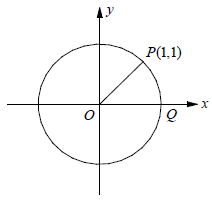
Solution :
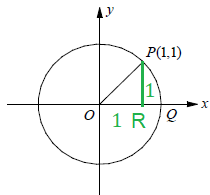
tan θ = opposite side / adjacent side
tan kπ = 1/1
tan kπ = 1
tan kπ = tan (π/4)
k = 1/4
Problem 5 :
In the -xy plane below, O is the center of the circle and the measure of ∠AOD is π/3. If the radius of circle O is 6 what is the length of AD?
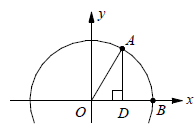
Solution :
∠AOD = π/3 = 60°
In triangle AOD,
OA = Hypotenuse = radius = 6 cm
OD = Smaller side and AD = Opposite to 60°
sin θ = opposite side / hypotenuse
sin θ = AD / OA
sin 60° = AD / 6
√3/2 = AD / 6
AD = (6√3/2)
AD = 3√3
Problem 6 :
Which of the following is equal to cos(π/8) ?
A) cos 3π/8 B) cos 7π/8
C) sin 3π/8 D) sin 7π/8
Solution :
Using complementary angles in trigonometry,
cos θ = sin (90 - θ)
cos(π/8) = sin ((π/2) - (π/8))
= sin (4π-π)/8
= sin 3π/8
Problem 7 :
In the figure below, what is the value of cos ∠AOD?
A) 3/5 B) 3/4 C) 4/5 D) 4/3
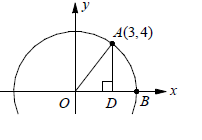
Solution :
Let ∠AOD = θ
cos θ = Adjacent side / hypotenuse = OD/OA ----(1)
OD = Adjacent side = 3
AD = Opposite side = 4
OA = √OD2 + AD2
OA = √32 + 42
OA = √(9+16)
OA = √25
OA = 5
cos θ = 3/5
Problem 8 :
In the right triangle shown below, if tan θ = 3/4, what is sin θ?
A) 1/3 B) 1/2 C) 4/5 D) 3/5
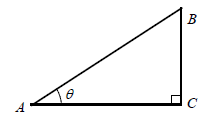
Solution :
tan θ = 3/4 = Opposite side / adjacent side
Hypotenuse(AB) = √32 + 42
AB = 5
sin θ = Opposite side / hypotenuse
sin θ = 3/5
Problem 9 :
In the xy-plane below, O is the center of the circle and the measure of ∠POQ is k π radians.
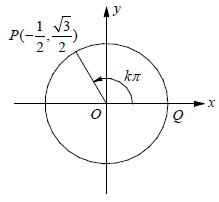
What is the value of k ?
A) 1/3 B) 1/2 C) 2/3 D) 3/4
Solution :
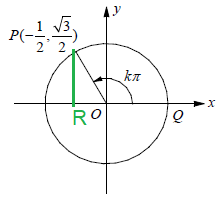
∠POR = θ
tan θ = opposite side / adjacent side
tan θ = (1/2) / (√3/2)
tan θ = 1/√3
θ = π/3
π/3 + k π = π
k π = π - (π/3)
k π = 2π/3
k = 2/3
Problem 10 :
In the right triangle ABC below, the cosine of x° is 3/5. If BC = 12, what is the length of AC?
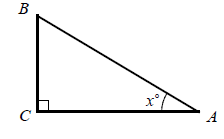
Solution :
cos x = 3/5 = Adjacent side / Hypotenuse = AC/AB
Adjacent side(AC) = 3a and hypotenuse (AB) = 5a
BC = 12
Opposite side (BC) = √(5a)2 - (3a)2
= √25a2 - 9a2
= √16a2
Opposite side (BC) = 4a
12 = 4a
a = 3
Adjacent side = 3a ==> 3(3) ==> 9
Recent Articles
-
Finding Range of Values Inequality Problems
May 21, 24 08:51 PM
Finding Range of Values Inequality Problems -
Solving Two Step Inequality Word Problems
May 21, 24 08:51 AM
Solving Two Step Inequality Word Problems -
Exponential Function Context and Data Modeling
May 20, 24 10:45 PM
Exponential Function Context and Data Modeling